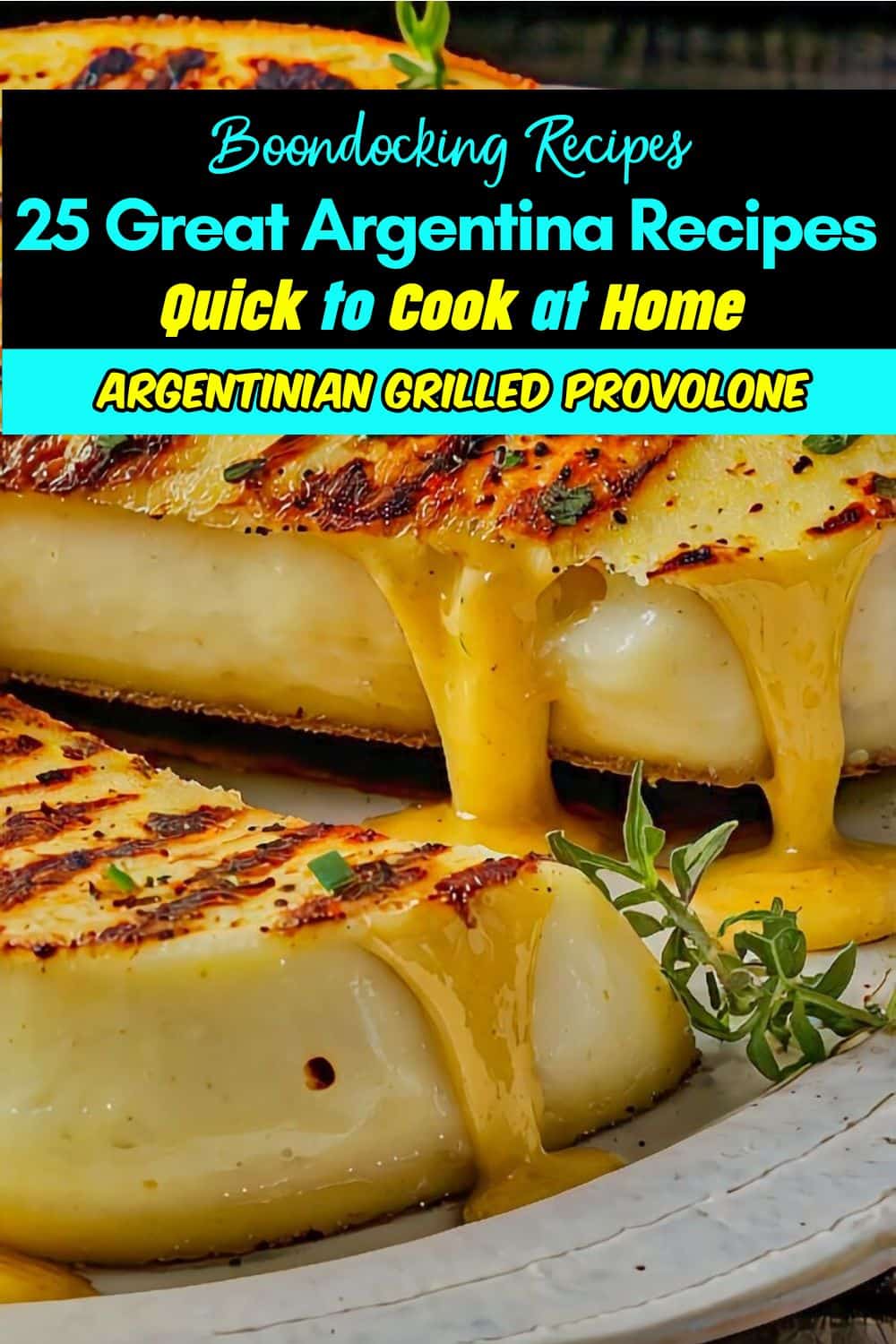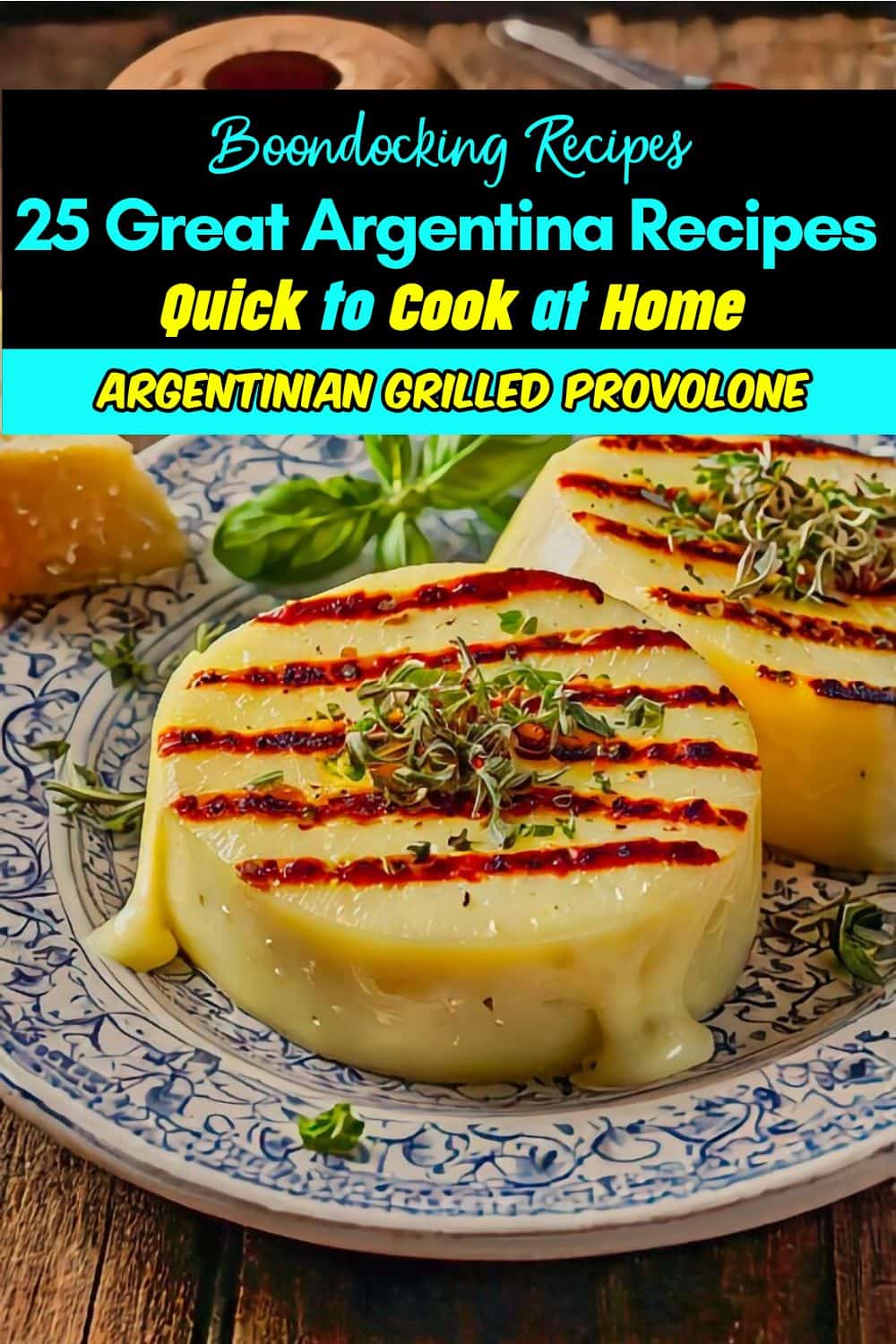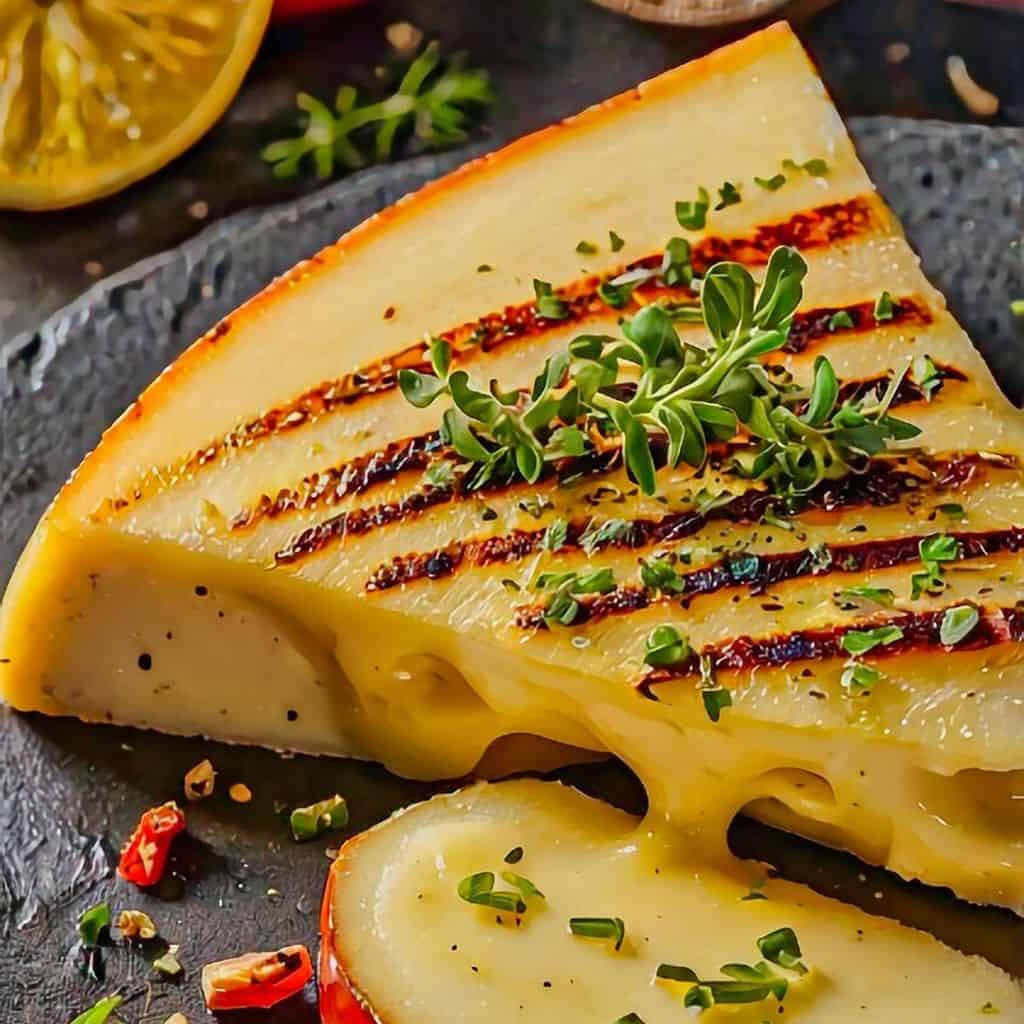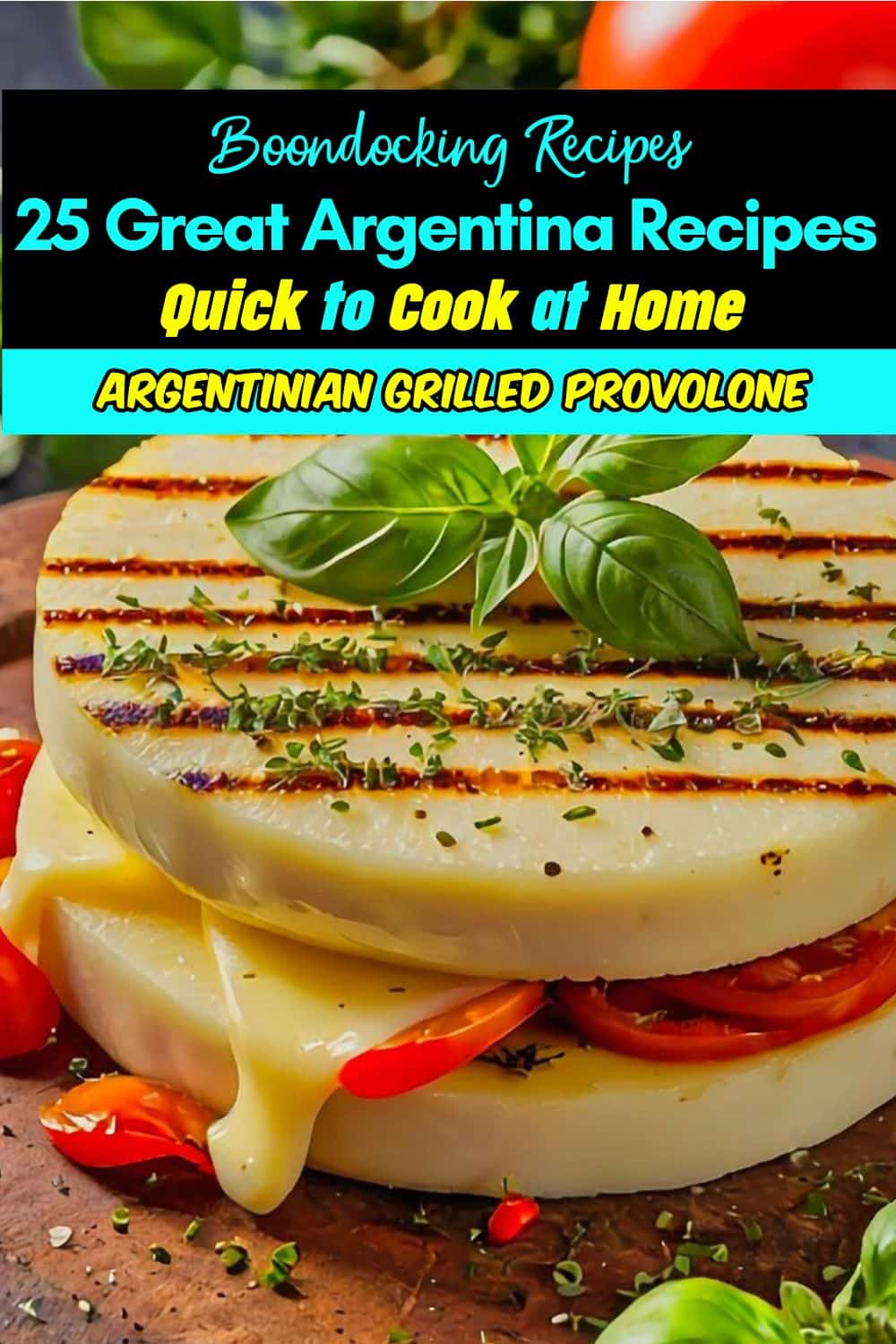Argentine Grilled Provolone, or provoleta, is a popular appetizer at Argentine Asado gatherings. This dish features a round of provolone cheese, grilled until it’s crispy on the outside and gooey on the inside, often topped with authentic chimichurri. Serve it alongside steaks pan-grilled Argentine style or Argentine-spiced steak for a delicious start to the meal. The combination of the smoky, melted cheese with the bright, herby chimichurri is a true testament to the bold flavors of Argentine cuisine.
The Argentine Grilled Provolone Recipe was a highlight of our culinary experience in Argentina. This dish featured a thick slice of provolone cheese that was expertly grilled to a golden brown. The cheese’s surface developed a crispy, caramelised crust while the inside remained soft and gooey, creating a delightful contrast in textures. The appearance of the Argentine Grilled Provolone was visually appealing, with its golden hue and slightly melted centre.
As we dug into the Argentine Grilled Provolone, the rich, creamy cheese offered a pleasing melt-in-your-mouth quality. The grilling process imparted a subtle smokiness that enhanced the cheese’s natural taste. The presentation was simple yet effective, showcasing the cheese’s glossy, browned exterior and inviting aroma. Each bite delivered a satisfying combination of crispiness and smoothness.
The Argentine Grilled Provolone was a perfect example of how straightforward techniques can highlight quality ingredients. Its delicious taste and appealing texture made it a memorable part of our food journey. The experience of enjoying this grilled cheese provided a great introduction to Argentina’s approach to cheese dishes.

Ingredients For the Argentine Grilled Provolone Recipe
Provolone Cheese
Dried Oregano
Cup Olive 0il
Cooking Instructions
- Preheat a grill or cast iron skillet over medium-high heat.
- Cut the provolone cheese into 1-inch slices.
- Place the cheese slices on the grill or skillet and cook for about 3-5 minutes on each side, until the cheese is melted and bubbly and has grill marks.
- Sprinkle the oregano over the cheese and drizzle with olive oil.
- Serve hot with grilled bread or crostini.
5 Reasons to Love the Argentine Grilled Provolone Recipe
1. Rich Grilling Tradition
Reason: The art of grilling, or asado, is deeply ingrained in Argentinian culture. The emphasis on high-quality beef and simple seasoning lets the natural flavors shine, making each bite satisfying.
2. Diverse Flavors
Reason: Argentinian cuisine offers a wide variety of flavors, from the tangy chimichurri sauce to the sweet richness of dulce de leche. This diversity means there’s always something new and exciting to taste.
3. Family Atmosphere
Reason: Every dish in Argentina tells a story, reflecting the country’s history and cultural influences. Whether it’s a traditional empanada or a comforting bowl of locro, each meal connects you to the country’s vibrant heritage.
4. Fresh, Local Ingredients
Reason: Argentinian food emphasizes fresh, local ingredients, from the beef to the vegetables used in salads. This focus on quality ensures that each dish is flavorful and nourishing.
5. Community and Family
Reason: Meals in Argentina are more than just about food; they are a way to bring people together. The communal experience of sharing an asado or a family dinner creates strong bonds and lasting memories.
10 Tips for Cooking Traditional Argentinian Recipes
1. Select the Best Beef Cuts
Tip: Choose cuts like ribeye, sirloin, or flank for traditional Argentinian dishes. Look for well-marbled meat for optimal flavor.
Why: The quality of the beef is crucial in Argentinian cuisine, where grilling (asado) is central. Well-marbled meat ensures tenderness and juiciness.
2. Use Hardwood Charcoal for Grilling
Tip: Opt for hardwood charcoal instead of briquettes when grilling. It burns hotter and imparts a smoky flavor to the meat.
Why: The type of charcoal used can significantly affect the taste of grilled dishes, a key element in Argentinian cooking.
3. Marinate with Simple Ingredients
Tip: Use basic marinades of olive oil, garlic, lemon, and fresh herbs for meats. Avoid overpowering the natural flavor of the meat.
Why: Argentinian cuisine values the natural taste of ingredients. Simple marinades enhance the flavor without overwhelming it.
4. Cook Empanadas with a Golden Crust
Tip: Brush empanadas with an egg wash before baking to achieve a golden, crispy crust.
Why: A golden crust not only improves the texture but also adds an appealing visual aspect, making the empanadas more appetizing.
5. Serve Chimichurri as a Condiment
Tip: Prepare chimichurri using fresh parsley, garlic, oregano, vinegar, and olive oil. Serve it alongside grilled meats.
Why: Chimichurri is a staple in Argentinian cuisine, complementing the rich flavors of grilled meats with its tangy and herbaceous profile.
6. Cook Milanesa to a Crispy Perfection
Tip: Fry breaded beef or chicken cutlets in hot oil until golden brown. Drain on paper towels to remove excess oil.
Why: The crispiness of Milanesa is key to its appeal. Proper frying ensures a crunchy exterior while keeping the meat tender inside.
7. Prepare Locro for a Hearty Meal
Tip: Slow-cook a mix of corn, beans, pork, and chorizo for several hours. Season with paprika, cumin, and bay leaves.
Why: Locro is a traditional stew enjoyed during national celebrations, and its long cooking time allows the flavors to meld together, creating a rich and hearty dish.
8. Use Fresh Ingredients for Salads
Tip: Include fresh tomatoes, lettuce, onions, and boiled eggs in salads. Dress with olive oil, vinegar, and salt.
Why: Fresh ingredients are essential in Argentinian salads, providing a crisp and refreshing contrast to heavier meat dishes.
9. Achieve the Perfect Dulce de Leche Consistency
Tip: Cook sweetened condensed milk slowly, stirring frequently until it thickens and turns a caramel color.
Why: Dulce de leche is a beloved dessert component in Argentina. Its smooth, rich texture enhances pastries and sweets like alfajores.
10. Serve Wine to Complement the Meal
Tip: Pair Argentinian dishes with Malbec wine, known for its deep flavor and smooth finish.
Why: Wine is a vital part of Argentinian dining culture. A well-chosen wine enhances the dining experience by complementing the flavors of the food.

5 FAQ For the Argentine Grilled Provolone Recipe
Q: What is Argentine grilled Provolone?
A: Argentine grilled Provolone, also known as “provoleta,” is a dish where Provolone cheese is grilled until it becomes golden and slightly crispy on the outside, while remaining soft and gooey on the inside.
Q: How do you make Argentine grilled Provolone?
A: To make Argentine grilled Provolone, slice a thick round of Provolone cheese, season it with oregano or chilli flakes, and grill it until it melts and forms a crispy crust.
Q: What do you serve with Argentine grilled Provolone?
A: Argentine grilled Provolone is often served with bread and chimichurri sauce, making it a popular appetiser in Argentina to enjoy before the main course of grilled meats.
Q: Can you grill Argentine Provolone on a regular grill?
A: Yes, you can grill Argentine Provolone on a regular grill, but it’s important to use a cast-iron skillet or a grill-safe pan to prevent the cheese from melting through the grates.
Q: What makes Argentine grilled Provolone different from regular Provolone?
A: Argentine grilled Provolone is different because it’s specifically prepared for grilling, often seasoned with spices like oregano, and served as an appetiser with a crispy exterior and melted centre.

Argentinian Grilled Provolone
Equipment
- Grill or cast iron skillet
Ingredients
- 2 lbs. provolone cheese
- 2 tbsp. dried oregano
- ¼ cup olive oil
Instructions
- Preheat a grill or cast iron skillet over medium-high heat.
- Cut the provolone cheese into 1-inch slices.
- Place the cheese slices on the grill or skillet and cook for about 3-5 minutes on each side, until the cheese is melted and bubbly and has grill marks.
- Sprinkle the oregano over the cheese and drizzle with olive oil.
- Serve hot with grilled bread or crostini.



1 comment
This works well with any dish but great with a slad dish, steak or potatoes.
Comments are closed.